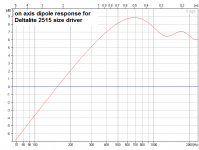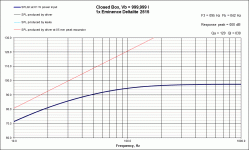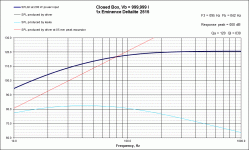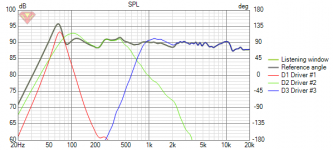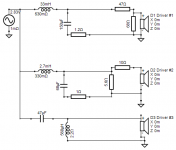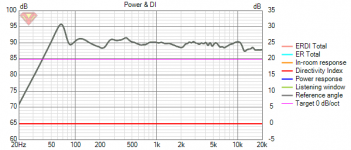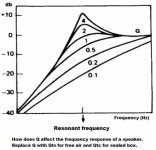Sure, open baffle bass is inefficient. That’s hardly news to the vast majority of people who like open baffles. So yes, it’s a strawman argument. Like almost all engineering problems in the real world, any approach requires compromise. Just choose your compromise and get on with it! Use multiple woofers, huge baffles, sealed subwoofers, equalization,, or any combination, amd it can be made to work fine….
100 Hz di-pole is doable, I suppose, but still, the net result will be poor efficiency.
Let me give you an example and you (and others reading) can decide for yourself. I will use the Eminence Deltalite 2515.
I have attached three plots. The first is the dipole response gain/loss curve for the 2515, nude, that is just the driver without an additional baffle. I created this curve using the Edge using accurate sized for the radiating area of the cone and OD of the driver frame. The second plot is the infinite box (closed box of infinite volume) response for the 2515, as created from the MFG TS parameters, and at 1W input power. The third is the same IB response, but this time at 200W. This causes the driver to reach Xmax at 80Hz.
Estimating 1W sensitivity:
To get an idea of what kind of sensitivity we can expect from the driver at a given frequency, we need to combine the dipole response gain/loss curve and the 1W IB response. Let's look at 100Hz. The gain/loss curve model shows a loss of about 3.5dB there. The 1W IB response SPL at 100Hz is about 95dB. The sum of these is about 91.5dB, so we can expect this to be the 1W sensitivity of the 2515, when used nude, and at 100Hz. Because the gain/loss curve is not flat, sensitivity is a function of frequency.
Estimating max SPL:
Along the same lines, we can use the excursion of the driver at higher power to estimate the max SPL for a given frequency. The 200W IB response for the 2515 at 100Hz is about 118dB, and the excursion is just under Xmax. Again, we add the gain/loss curve value at this frequency (-3.5dB, as above) to get the SPL level, which is 114.5dB.
Comments:
For home audio, a 1W sensitivity of 91.5dB is above average. There are no additional "baffle step" losses that need to be factored in, like what is done with a closed box. This sensitivity is relatively high because the dipole losses are just not all that high at 100Hz and the driver's own IB sensitivity at 100Hz is high. Only modest input power (50W is plenty!) will be necessary for practical home use, since few people will need to reach 115dB with their speaker. Still, this driver (even without a baffle) will produce a lot of SPL at 100Hz if you want it to.
If you try to operate this driver down to 50Hz (another octave lower), the dipole losses increase by 6dB. Also, as you can see from the IB response curves, the driver's own output is falling off at 50Hz because you are nearing Fs, and this would add a further 5-6dB decrease in SPL. While you can try to compensate for this by increasing power as frequency decreases, you would need 12dB (8 times) more power at 50Hz! Since we are already near Xmax at 100Hz, the maximum output at 50Hz is also 12 dB lower. Not only would this require very high input power that may exceed Pe, the driver does not have Xmax to produce the same output at 50Hz compared to 100Hz. It's a losing proposition.
I find it better to keep the usable sensitivity high by not doing that, and instead cross over to another driver that is better suited to provide the necessary SPL at these lower frequencies. When builders allow the losses to compound too much, they can find themselves disappointed by the result. Even though this is a 15" driver, I cross over no lower than 80Hz, especially because of its limited Xmax. By removing the low end requirement, excursion is kept low and this driver can be used as high in frequency as is practical, which turns out to be remarkably high for its 15" size.
Attachments
Last edited:
Nice presentation Charlie. I enjoy all type of speakers, they all have their charms! In my house I have:
-DIY 2 way PA type ported box speaks with long travel 12” woofers and horn tweeters , used mostly for dance parties. Excellent to keep from blowing the other speakers:
-DIY 3 way Basszilla speakers with ribbon teeeter, open baffle dipole Fostex wide midrange, and ported box 15” woofers. Great for symphonies! Esp. With video.
-Commercial small 2 way box speakers,
-DIY 2 way Linkwitz LXmini speakers which have sealed “box’” omnidirectional woofers and resistive loaded mid/tweet
-DIY 2 way In progress but I’ve heard them: all open baffle dipole panel with Hawthorne Augie 12” bass and SAL full range. The Best for jazz combos and other smaller scale stuff
-DIY 4 way in progress but I’ve heard them a lot: Linkwitz LX521 open baffle dipole speakers. With 2 10” SEAS OB subwoofers each side.
-I’ll never be able to afford them but I heard the MBL omnidirectional speaks in a large room and felt like I was in Symphony Hall!
I just love the dipoles, but sure like the others, often depending on the music. Horses for courses. Of course I added a room to the house recently. My wife just sighs and Says “I knew this this was part of the deal”
-DIY 2 way PA type ported box speaks with long travel 12” woofers and horn tweeters , used mostly for dance parties. Excellent to keep from blowing the other speakers:
-DIY 3 way Basszilla speakers with ribbon teeeter, open baffle dipole Fostex wide midrange, and ported box 15” woofers. Great for symphonies! Esp. With video.
-Commercial small 2 way box speakers,
-DIY 2 way Linkwitz LXmini speakers which have sealed “box’” omnidirectional woofers and resistive loaded mid/tweet
-DIY 2 way In progress but I’ve heard them: all open baffle dipole panel with Hawthorne Augie 12” bass and SAL full range. The Best for jazz combos and other smaller scale stuff
-DIY 4 way in progress but I’ve heard them a lot: Linkwitz LX521 open baffle dipole speakers. With 2 10” SEAS OB subwoofers each side.
-I’ll never be able to afford them but I heard the MBL omnidirectional speaks in a large room and felt like I was in Symphony Hall!
I just love the dipoles, but sure like the others, often depending on the music. Horses for courses. Of course I added a room to the house recently. My wife just sighs and Says “I knew this this was part of the deal”
Last edited:
When I made a baffleless speaker with two of these woofer SB Acoustics SB34NRX75-16 12" Woofer, 16 ohm I dialed in the 6dB/octave SLP in the MINIDSP and played a tune our of curiosity. The bass was very dominant. I then did a sweep (REW and UMIK) and indeed the bass was very dominant, and I had to reduce the bass correction, almost eliminating it to have a relatively flat response on axis. I was surprised by that, searched around and found more comments (and measurements) that the dipole correction was not necessary or way less than expected (sometimes due to a high Qts woofer). Anyway, I kept searching information and found this study by John K Dipole on axis Hm, interesting. I just put the title in google and found these measurements On Dipole Subwoofer Placement
Rudolf commented something about it here, (post 5677) https://www.diyaudio.com/forums/multi-way/100392-beyond-ariel-284.html#post1831060
"I can follow "Dipole woofer on axis response in relation to listening distance" quite easily. If you are going from far field to near field, you need ever less compensation for the 6dB dipole rolloff. In praxis you have to count in the floor reflection and the room modes of course, so things become more complicated. But I always found that I had to EQ less than 6 dB/oct - unless I tried to force EQ below the lowest room mode."
Someone else noticed this effect and had to use less dipole correction than the standard "6dB/octave below f equal" (took f equal from the 2nd picture here Electro-acoustic models)
Rudolf commented something about it here, (post 5677) https://www.diyaudio.com/forums/multi-way/100392-beyond-ariel-284.html#post1831060
"I can follow "Dipole woofer on axis response in relation to listening distance" quite easily. If you are going from far field to near field, you need ever less compensation for the 6dB dipole rolloff. In praxis you have to count in the floor reflection and the room modes of course, so things become more complicated. But I always found that I had to EQ less than 6 dB/oct - unless I tried to force EQ below the lowest room mode."
Someone else noticed this effect and had to use less dipole correction than the standard "6dB/octave below f equal" (took f equal from the 2nd picture here Electro-acoustic models)
An old graph that is often forgotten. (bass roll-off towards fs vs. Qts/Qtc)sometimes due to a high Qts woofer
I consider high Qts-woofers as woofers with built in EQ.
Take that Visaton WS25E you´re using for instance; it plays down to its fs easily but just as an heavily EQed woofer you´d have to watch excursion if you don´t high-pass it or take 2-4 per side (depending on aimed SPL).
That said there is probably a sweet spot for Qts (in contrast to higher Qts is better). Can´t remember where and why but Linkwitz mentioned a Qts of 0.5 appropriate.**
One has to consider though that his speaker systems were mostly active.
When designing passive it makes life/XO easier when using a woofer with Qts>=0.5.
** found it: see Q34:
Frequently Asked Questions
Attachments
Last edited:
Pretty much predictable replies
All on the defensive. I really hesitated to post again, because I know my efforts
are a non gratuitous endevour.
The defensive themes are all what i have read before. Denial of front-to-back cancellation. Okay, drink your kool-aide, while I keep a copies of various Harry F. Olson reference books on my shelf.
1) The strawman belongs in the Wizard of Oz.
2) Efficiency and s.p.l. sensitivity are not exactly the same thing.
3) you can do NO BETTER on an open baffle than what a driver does on an IEC baffle. Any deviations are caused by the room. That nasty rear-wave does not magically add back in a uniform manner.
4) an open baffle is the most simple form of loudspeaker. It's rate of roll-off is the most shallow of all, at 6db/octave. The upper hinge point of said roll-off is determined by baffle size. Rectangular baffles are more effective than square (or God forbid) round.
5) The Detalite 2515 is not an open baffle woofer. John, over there at Acoustic Elegance makes application specific drivers, for those wishing to investigate further.
6) A proper enclosure married to a driver does what? It raises the resonant frequency and lowers the amplitude of said resonance. If the novice wishes to use any given driver for bass, all the way down,after they have cut a hole-in-a-plank, they are using a highly resonant device. Imagine this foolish attempt at the same time speaking out the other corner of their mouth about resonant boxes.
7)Boxes can and do cause colourations to the original. All speakers do. The task at hand is to learn how to reduce these colourations to a low enough level; they are not bothersome. Bass enclosures should be operated in their pressure vessel range only, to avoid standing waves. Dual-opposed woofers reduce vibration-induced colourations almost completely. That only leaves the air pressure inside the box, acting on walls of said box. A box effective at low frequencies should not be built to the standard of a mid-bass/mid-range box. (Another entire lengthy discussion) The higher the drivers' excursion, the less pressure. The higher the system efficiency the less excursion. My woofers move 1/64th of an inch to produce 90db at the listening position. Try that with your fools-errand open baffle non-sense.
Gentlemen, I wish you farewell, and the best of luck.
All on the defensive. I really hesitated to post again, because I know my efforts
are a non gratuitous endevour.
The defensive themes are all what i have read before. Denial of front-to-back cancellation. Okay, drink your kool-aide, while I keep a copies of various Harry F. Olson reference books on my shelf.
1) The strawman belongs in the Wizard of Oz.
2) Efficiency and s.p.l. sensitivity are not exactly the same thing.
3) you can do NO BETTER on an open baffle than what a driver does on an IEC baffle. Any deviations are caused by the room. That nasty rear-wave does not magically add back in a uniform manner.
4) an open baffle is the most simple form of loudspeaker. It's rate of roll-off is the most shallow of all, at 6db/octave. The upper hinge point of said roll-off is determined by baffle size. Rectangular baffles are more effective than square (or God forbid) round.
5) The Detalite 2515 is not an open baffle woofer. John, over there at Acoustic Elegance makes application specific drivers, for those wishing to investigate further.
6) A proper enclosure married to a driver does what? It raises the resonant frequency and lowers the amplitude of said resonance. If the novice wishes to use any given driver for bass, all the way down,after they have cut a hole-in-a-plank, they are using a highly resonant device. Imagine this foolish attempt at the same time speaking out the other corner of their mouth about resonant boxes.
7)Boxes can and do cause colourations to the original. All speakers do. The task at hand is to learn how to reduce these colourations to a low enough level; they are not bothersome. Bass enclosures should be operated in their pressure vessel range only, to avoid standing waves. Dual-opposed woofers reduce vibration-induced colourations almost completely. That only leaves the air pressure inside the box, acting on walls of said box. A box effective at low frequencies should not be built to the standard of a mid-bass/mid-range box. (Another entire lengthy discussion) The higher the drivers' excursion, the less pressure. The higher the system efficiency the less excursion. My woofers move 1/64th of an inch to produce 90db at the listening position. Try that with your fools-errand open baffle non-sense.
Gentlemen, I wish you farewell, and the best of luck.
All on the defensive. I really hesitated to post again, because I know my efforts
are a non gratuitous endevour.
The defensive themes are all what i have read before. Denial of front-to-back cancellation. Okay, drink your kool-aide, while I keep a copies of various Harry F. Olson reference books on my shelf.
1) The strawman belongs in the Wizard of Oz.
2) Efficiency and s.p.l. sensitivity are not exactly the same thing.
3) you can do NO BETTER on an open baffle than what a driver does on an IEC baffle. Any deviations are caused by the room. That nasty rear-wave does not magically add back in a uniform manner.
4) an open baffle is the most simple form of loudspeaker. It's rate of roll-off is the most shallow of all, at 6db/octave. The upper hinge point of said roll-off is determined by baffle size. Rectangular baffles are more effective than square (or God forbid) round.
5) The Detalite 2515 is not an open baffle woofer. John, over there at Acoustic Elegance makes application specific drivers, for those wishing to investigate further.
6) A proper enclosure married to a driver does what? It raises the resonant frequency and lowers the amplitude of said resonance. If the novice wishes to use any given driver for bass, all the way down,after they have cut a hole-in-a-plank, they are using a highly resonant device. Imagine this foolish attempt at the same time speaking out the other corner of their mouth about resonant boxes.
7)Boxes can and do cause colourations to the original. All speakers do. The task at hand is to learn how to reduce these colourations to a low enough level; they are not bothersome. Bass enclosures should be operated in their pressure vessel range only, to avoid standing waves. Dual-opposed woofers reduce vibration-induced colourations almost completely. That only leaves the air pressure inside the box, acting on walls of said box. A box effective at low frequencies should not be built to the standard of a mid-bass/mid-range box. (Another entire lengthy discussion) The higher the drivers' excursion, the less pressure. The higher the system efficiency the less excursion. My woofers move 1/64th of an inch to produce 90db at the listening position. Try that with your fools-errand open baffle non-sense.
Gentlemen, I wish you farewell, and the best of luck.
Who hurt your feelings so badly? Lol. Or are you wanting to get everyone to concede you're right? Clearly, you're knowledgeable and know a thing or two about audio. Some things you say, I agree with. That said, experience has told me whilst not perfect, open baffleismuch more than the meaningless pursuit you make it out to be. That is my major disagreement with your arguments. It would be boring if everyone did the same thing, and it should also be apparent there is more than 1 way to skin a cat.
As for your 1/64" of swing you're on about... I never thought to measure but definitely got me there. That leaves a lot of room for volume. I can dig that.
It's fun to have people drop in from time to time to tell us how bad something is, or how technically inept and ignorant we are.
Posts like that actually give us a chance to show that we do understand the engineering and the limits. The replies go back over the important issues and help us refresh our memories and clarify certain important points. The discussions might also be useful for people new to the subject.
Posts like that actually give us a chance to show that we do understand the engineering and the limits. The replies go back over the important issues and help us refresh our memories and clarify certain important points. The discussions might also be useful for people new to the subject.
Well said Pano, I totally agree.
I also agree with many of the members posts who enjoy great quality bass on open baffle systems, plus the easier room integration.
My personal choice in a family music/home cinema/ games room is all sealed box, but.... If I had a dedicated music / home cinema room I would use open baffle between 60Hz and 300Hz with sealed box subs below 60Hz and sealed box mids above 300Hz.
Cheers
A.
I also agree with many of the members posts who enjoy great quality bass on open baffle systems, plus the easier room integration.
My personal choice in a family music/home cinema/ games room is all sealed box, but.... If I had a dedicated music / home cinema room I would use open baffle between 60Hz and 300Hz with sealed box subs below 60Hz and sealed box mids above 300Hz.
Cheers
A.
Yes, physics matters. But it is is false analysis to post textbook concepts when we are talking about dipoles in rooms. For the moment, nobody can predict results due to the complexity of the setting (not to mention, one more time again, benefitting from driver resonance bump-up).
And that is why some folks are posting smooth 6DB/8ave losses and other folks swearing there's barely a drop-off in their own OB systems. Both are right, of course, but we need to trust the people with actual in-situ measurement experience.
BTW, absolutely ridiculous that this arm-chair discussion goes on and on with nobody posting measurements. Shame.
B.
And that is why some folks are posting smooth 6DB/8ave losses and other folks swearing there's barely a drop-off in their own OB systems. Both are right, of course, but we need to trust the people with actual in-situ measurement experience.
BTW, absolutely ridiculous that this arm-chair discussion goes on and on with nobody posting measurements. Shame.
B.
It's fun to have people drop in from time to time to tell us how bad something is, or how technically inept and ignorant we are.
Posts like that actually give us a chance to show that we do understand the engineering and the limits. The replies go back over the important issues and help us refresh our memories and clarify certain important points. The discussions might also be useful for people new to the subject.
Yeah but now it’s bordering on trolling...
I'm running 18" on OB (80-700Hz) and sealed boxes below that.
"My woofers move 1/64th of an inch to produce 90db at the listening position. Try that with your fools-errand open baffle non-sense."
My OB driver is big and highpassed, so it doesn't need to move a lot.
This isn't rocket surgery
"My woofers move 1/64th of an inch to produce 90db at the listening position. Try that with your fools-errand open baffle non-sense."
My OB driver is big and highpassed, so it doesn't need to move a lot.
This isn't rocket surgery
All on the defensive. I really hesitated to post again, because I know my efforts
are a non gratuitous endevour.
than enjoy ...try a FR in OB too you will discovery what magic back emission can do.....
The way things are, do you see any sound logic upon which to be concerned?Yeah but now it’s bordering on trolling...
I was waiting for this to become a discussion to separate the myths from the facts. To all sides this could have been both enjoyable and profitable. Alas (that ship has sailed).
- Home
- Loudspeakers
- Multi-Way
- Which 15 or 18 ınch woofer- best for open baffle
